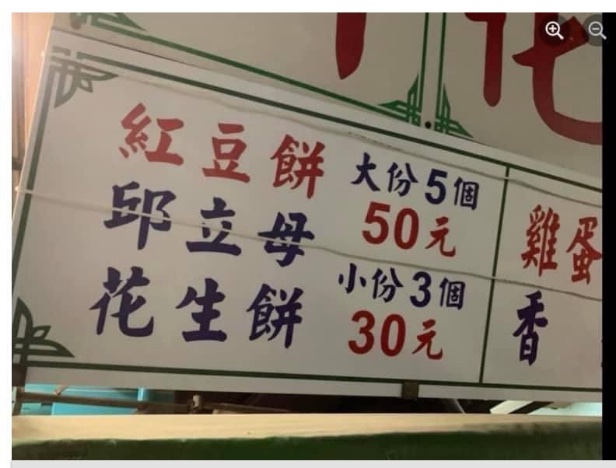Topolectal transcription
« previous post | next post »
Part of a menu in Taiwan:
The line at the top, hóngdòu bǐng 紅豆餅, is for "red bean cake". The line at the bottom, huāshēng bǐng 花生餅, is for "peanut cake". It's the line in the middle that puzzles a monolingual Mandarin speaker:
qiūlìmǔ 邱立母
Character by character, that would mean "mound — stand (erect) — mother".
In Taiwanese, qiūlìmǔ 邱立母 would be pronounced like "kulimu" ("cream"), with which compare Japanese "kurīmu クリーム" ("cream").
This reminds me of a funny story about my son and his maternal grandma, my mother-in-law. When he was about two years old and fluent only in Mandarin, his wàipó 外婆 took him to the nearby McDonald's in Somerville, Massachusetts, and he asked her to buy him some bīngqílín 冰淇淋 (that's the Mandarin word for "ice cream"). My mother-in-law didn't speak a word of English, but she knew that the latter part of "bīngqílín 冰淇淋" was a foreign word, so she very cleverly thought to herself that she'd just say the "qílín 淇淋" (transcription of English "cream") part with what she perceived to be a foreigner's "twist". So she walked up to the counter and announced confidently: "binkteelink!" At first the person at the counter was dumbfounded, but she kept repeating the word and making animated gestures, so finally my son got what he wanted.
Selected readings
- "Political vocabulary and Brother Cream" (7/26/16)
- "'Farcical names'" (4/3/15)
- "Turkic kaymak and Sinitic sū: a dairy product and a food texture" (3/27/20)
- "Arablish" (9/23/18)

julie lee said,
February 13, 2022 @ 5:51 pm
Oh, now I realize why bīngqílín 冰淇淋 is "ice-cream" in Mandarin.
I knew "bing" was "ice" , but what the dickens was "qílín 淇淋"
(pronounced like English "cheelin") ?
Now I see, thanks to the post, that qílín 淇淋, pronounced "keilum"
in Cantonese, is like Taiwanese "kulimu" for "cream". Mystery
solved.
John Rohsenow said,
February 13, 2022 @ 7:20 pm
I guess I have to agree; I learned the term bīngqílín 冰淇淋 'on the fly' as it were (we used to say "picked up on the street in the gutter") in Taiwan while at the IUP "Stanford Center" back in the day, first orally and then from signage, and must admit that altho' I did identify the 'bing' part as 'ice' (even before I saw it written), but (unlike Victor's mo-in-law) it (had)
never occurred to me specifically where the 'qilin' part came from, or
(consciously) that it sounded like 'cream/kulimu' until I read this posting. ..WHICH, I suppose, is how one is 'supposed' to learn language.
How this relates to the fact that many Chinese were lactose intolerant until (powdered) cow's milk and other dairy products were introduced after WW II is another story.
Lisa R-R said,
February 13, 2022 @ 8:19 pm
I believe there is a different Cantonese term for ice cream – syut gou.
雪糕
Is the term that sounds like “bing keilum” still used as well?
Calvin said,
February 14, 2022 @ 11:26 pm
In Hong Kong, Cantonese term for cream is 忌廉 (gei6 lim1), though ice cream is 雪糕 but not 冰忌廉.
A popular local soft drink is cream soda made by Schweppes HK. It is called 忌廉梳打 (gei6 lim1 so1 daa2). Otherwise, 梳打水 ("soda drink") is an archaic term replaced by 汽水 ("carbonated drink").
In China and Taiwan, cream is usually called 奶油 ("milk oil"), so 淇淋 is a one-off, seemingly just for 冰淇淋.
Chas Belov said,
February 15, 2022 @ 12:24 am
Syut gou 雪糕 is the one they taught us in Cantonese class for ice cream
Michael Watts said,
February 20, 2022 @ 8:37 am
I was going to ask about this too. The word for cream is 奶油. What is the 邱立母 on the menu supposed to represent?
I'm curious about the other half of the panel too – it seems to say "5 for 50 yuan or 3 for 30 yuan". Wouldn't it be simpler to say "10 yuan each"? And 5 what? I can understand 5 bean cakes or 5 peanut cakes. 5 creams?